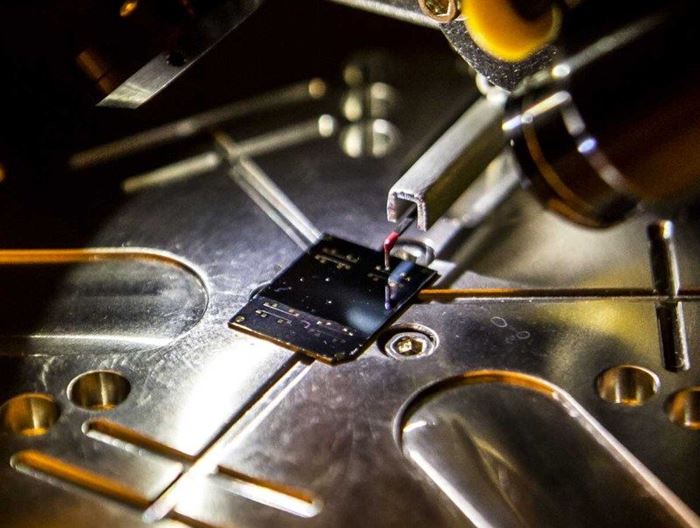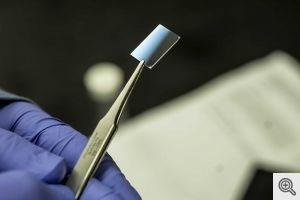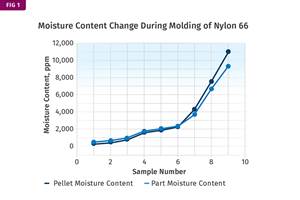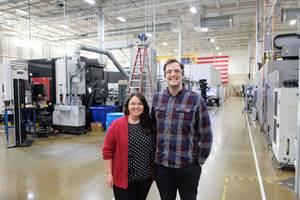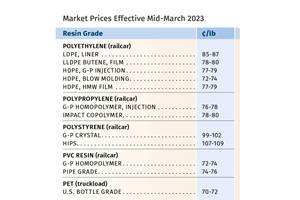‘Engineering’ Plastic Structure for Thermal Conductivity
U. of Michigan researchers’ process is a major departure from past approaches to rendering thermal conductivity to plastics.
Share
Over the last several years, achieving thermal conductivity in plastics in applications such as high-power density electronic devices, automotive cooling systems, and batteries, where heat accumulation can have deleterious effects, has been achieved by blending the plastics with highly thermally conductive fillers such as metal or ceramic particles, carbon nanotubes (CNTs), or graphene flakes.
The key challenge, however, has been the large volume fraction of such fillers required to achieve appreciable enhancement in thermal conductivity, which often leads to undesired optical or electrical properties, increased weight, high cost, and at times loss of the easy processability typically associated with plastics.
Plastics are replacing metals and ceramics in many places, but they’re such poor heat conductors that nobody ever considers them for applications that require heat to be dissipated efficiently.
Help could be on the way thanks to a team of researchers from the materials science and mechanical engineering sectors of the University of Michigan (U-M), Ann Arbor, Mich. “Plastics are replacing metals and ceramics in many places, but they’re such poor heat conductors that nobody ever considers them for applications that require heat to be dissipated efficiently….We’re working to change that by applying thermal engineering to plastics in a way that hasn’t been done before,” according to Jinsang Kim, U-M material science and engineering professor.
Representing a major departure from previous approaches, this technique uses a process that engineers the structure of the material itself. Plastics are made of long chains of molecules that are tightly coiled and tangled like a bowl of spaghetti. As heat travels through the material, it must travel along and between these chains—an arduous, roundabout journey that impedes its progress.
The U-M team—which includes associate professor of mechanical engineering Kevin Pipe, mechanical engineering graduate researcher Chen Li and materials science and engineering graduate student Apoorv Shanker—used a chemical process that expand and straighten the molecule chains—essentially giving heat energy a more direct route through the material.
The team started with a typical amorphous plastic—in this case, a weak polyelectrolyte, polyacrylic acid (atactic PAA). First, the polymer is dissolved in water, then electrolytes are added to the solution to raise its Ph, making it alkaline. The individual links—monomers—in the polymer chain take on a negative charge, which causes them to repel each other. As they spread apart, they unfurl the chain’s tight coil. Next, the water and polymer solution is sprayed onto plates using a common industrial process called spin casting, which reconstitutes it into a solid plastic film.
The uncoiled molecule chains now make heat easier to travel through the plastic. A secondary benefit found: the process stiffens the polymer chains and helps them flock together more tightly, making them even more thermally conductive. Noted Shanker, “Polymer molecules conduct heat by vibrating, and a stiffer molecule chain can vibrate more easily…think of a tightly stretched guitar string compared to a loosely coiled piece of twine. The guitar string will vibrate when plucked, the twine won’t. Polymer molecule chains behave in a similar way.”
Representing a major departure from previous approaches, this technique uses a process that engineers the structure of the material itself.
This team endeavor can have important consequences due to the large number of plastics applications in which temperature is important, according to Pipe. “Researchers have long studied ways to modify the molecular structure of polymers to engineer their mechanical, optical or electronic properties, but very few studies have examined molecular design approaches to engineer their thermal properties….while heat flow in materials is often a complex process, even small improvements in the thermal conductivities of polymers can have a large technological impact.”
Next for this team: Making composites that combine the new technique with several other heat dissipating strategies to further increase thermal conductivity. Also, they are exploring how to apply the concept to other types of polymers. A commercial product is likely to be a few years away. Concludes Li, “We’re looking at using organic solvents to apply this technique to non-water soluble polymers…but we believe the concept of using electrolytes to thermally engineer polymers is a versatile idea that will apply across many other polymers.”
One thing is for certain, according to industry studies, the annual market demand growth for thermally conductive plastics appears to be in the double-digit range.
Related Content
Soft Prices for Volume Resins
While PP and PE prices may be bottoming out, a downward trajectory was likely for all other volume resins, including engineering types.
Read MoreWhat's the Allowable Moisture Content in Nylons? It Depends: Part 2
Operating within guidelines from material suppliers can produce levels of polymer degradation. Get around it with better control over either the temperature of the melt or the barrel residence time.
Read MoreScaling Up Sustainable Solutions for Fiber Reinforced Composite Materials
Oak Ridge National Laboratory's Sustainable Manufacturing Technologies Group helps industrial partners tackle the sustainability challenges presented by fiber-reinforced composite materials.
Read MorePrices of Volume Resins Generally Flat or Lower
Exceptions in early March were PP and PS, which moved up solely due to feedstock constraints, along with slight upward movement in PVC and PET.
Read MoreRead Next
Precision Processing Requires Precision Equipment
Moretto offers plastics processors and micromolders for a broad suite of auxiliary solutions targeted specifically for precision processing.
Read MoreLead the Conversation, Change the Conversation
Coverage of single-use plastics can be both misleading and demoralizing. Here are 10 tips for changing the perception of the plastics industry at your company and in your community.
Read More

